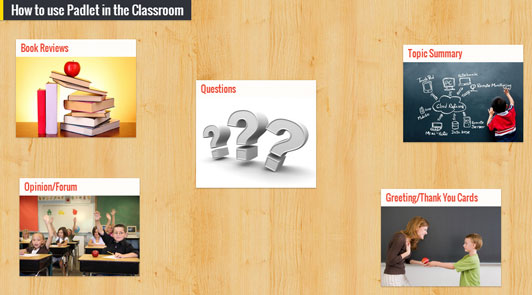Padlet
Padlet
When students are engaged in collaborative work, Padlet is a great assistive tool for the classroom. It works like a bulletin board but digitally. Students can post in several different forms. Padlet works as a starting point where any student can participate. It is easy, universal, and inclusive. Padlet supports just about every file type and has an App for almost any device. It creative, fun, private, and secure. Padlet is flexible and versatile for any student to use. Using Padlet is simple, just go to the Padlet website and sign up for free to create an account and make you first board. When you have done that you share the board to your students with a QR code, link, or which ever option you choose from Padlet. Uses for Padlet in the classroom are endless, if you need some ideas, Lucy Renard has 30 Creative Ways to use Padlet for Teachers and Students. In the article she explains how to use Padlet and then list 30 ways to use it. If 30 seems to be overwhelming, Education World has Five Ways to use Padlet in the Classroom.

Zoan, I LOVED Padlet when I was in the classroom, and I have seen it used in lots of different ways. I used it most for warm-ups, and the students were super-engaged - but one time we even went so far as to create a Padlet with a class in another state. Padlet's features have only continue to improve (I often had students post on the Padlet and then respond to each other's posts), but I was disappointed in the latest update, where they limited the number of boards that teachers can have at one time - seems like a step in the wrong direction, as I never wanted to delete old boards. Thanks for the ideas on how to use Padlet, though, as an assistive tool.
ReplyDeleteI also used Padlet in the classroom and didn't consider it as an "assistive tool" until the last few years. I found that many of the posts from my students were on a deeper level and more emotionally vulnerable than if I had them respond out loud verbally. Students with anxiety preferred the anonymity and wait-time helped those who processed directions more slowly, to be able fully think through their responses. I like the idea of promoting it as a Universal Design tool as it may help teachers think more critically about their student's needs. Thanks for the post!
ReplyDeleteHi Zoe! I have heard of Padlet but have never used it in my classroom. When I went to the Gallery on the Padlet website, I found tons of great ideas. One idea was Fact or Fiction where the user can "thumbs up" or "thumbs down" whether something is true or not. There was also a book report Padlet that could be used in the library. Thanks for sharing!
ReplyDeleteZoan, I have used Padelt in my classroom before, but it has been a long time, to tell you the truth with all of the app we have in CCSD I have forgotten about. In the past when I used it I my students loved it because of the interactive features and the collaboration it allowed. I think it is a wonderful assistive tool. It allows the students to work together without the fear of embarrassment for being called on or questioned about their answer. Students can work in groups allowing for all students to be successful.
ReplyDeleteZoan, you did not address how padlet would be used as an assistive technology in this post. While the post is a great introduction to padlet as a web 2.0 tool, it does not address this week's module.
ReplyDelete